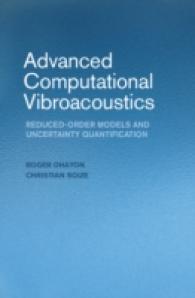- ホーム
- > 洋書
- > 英文書
- > Science / Mathematics
Full Description
Biosensors are poised to make a large impact in environmental, food, and biomedical applications, as they clearly offer advantages over standard analytical methods, including minimal sample preparation and handling, real-time detection, rapid detection of analytes, and the ability to be used by non-skilled personnel. Covering numerous applications of biosensors used in food and the environment, Portable Biosensing of Food Toxicants and Environmental Pollutants presents basic knowledge on biosensor technology at a postgraduate level and explores the latest advances in chemical sensor technology for researchers.
By providing useful, state-of-the-art information on recent developments in biosensing devices, the book offers both newcomers and experts a roadmap to this technology. In the book, distinguished researchers from around the world show how portable and handheld nanosensors, such as dynamic DNA and protein arrays, enable rapid and accurate detection of environmental pollutants and pathogens.
The book first introduces the basic principles of biosensing for newcomers to the technology. It then explains how the integration of a "receptor" can provide analytically useful information. It also describes trends in biosensing and examines how a small-sized device can have portability for the in situ determination of toxicants. The book concludes with several examples illustrating how to determine toxicants in food and environmental samples.
Contents
Photonic Crystal Waveguide Sensing. Electrochemical Biosensor. Piezoelectric Sensors. Surface-Enhanced Raman Scattering-Based Biosensors. Enzymatic Biosensors. Antibody-Based Biosensors. Ion Channel Switch- and Lipid Film-Based Biosensors. Oligonucleotide and Nucleic Acid-Based Biosensors. DNA Synthesis and Its Biosensor Detection. Aptasensors: The New Trends. Tissue, Microorganisms, Organelles, and Cell-Based Biosensors. Nanotechnology and Nanofabrication Applications in Chemical Sensing. Bioelectronic Tongues. Molecularly Imprinted Polymer-Based Biosensors. Lab-on-a-Chip and Microfluidic Technology. Biosensors in Quality Assurance of Dairy Products. Water-Soluble Vitamin and Drug Residue Determination. Optical Biosensors in Food Safety and Control. Biosensors in Express Control of Quality Assurance of Products. Efficiencies of Biosensors in Environmental Monitoring. Application of Biosensors on Air Pollution Monitoring. Oligonucleotide and DNA Microarrays as Versatile Tools for. Biosensors for Pesticides and Foodborne Pathogens. Micro- and Nanopatterning for Bacteria- and Virus-Based Electrochemical DNA Biosensors in Food Safety: Determination of Phenolic Compounds and Antioxidant Capacity in Foods and Beverages. Biosensors in Quality of Meat Products. Microbial Cells and Enzymes for Assaying the Fermentation Processes of Alcohol Production: Starch, Glucose, Ethanol, BOD. Biosensors in the Control of Biochemical Quantities in the Diagnostics of Diseases.








